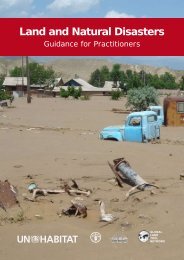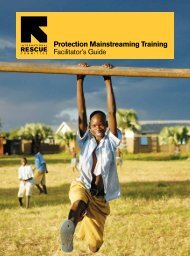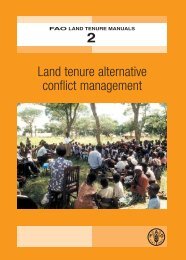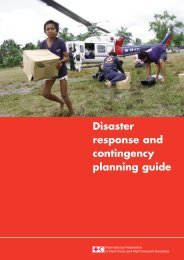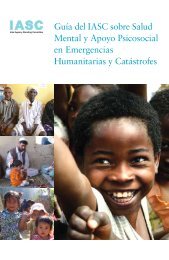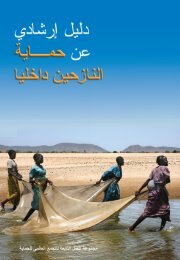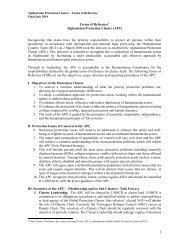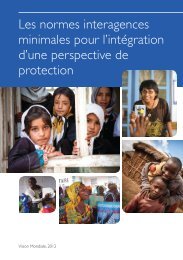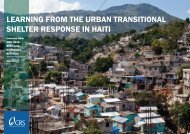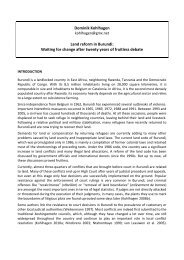Inter-Agency Real Time Evaluation of the Response to Cyclone Nargis
Inter-Agency Real Time Evaluation of the Response to Cyclone Nargis
Inter-Agency Real Time Evaluation of the Response to Cyclone Nargis
You also want an ePaper? Increase the reach of your titles
YUMPU automatically turns print PDFs into web optimized ePapers that Google loves.
Annex 4: Inception Report1. Objective and scope <strong>of</strong> <strong>the</strong> evaluation1.1 Objective:In recent years, efforts have been increasingly directed <strong>to</strong>wards improving humanitarian responsethrough learning and accountability. The <strong>Inter</strong>-<strong>Agency</strong> <strong>Real</strong> <strong>Time</strong> <strong>Evaluation</strong> (IA RTE) – endorsedby <strong>the</strong> <strong>Inter</strong>-<strong>Agency</strong> Standing Committee (IASC) Working Group in March 2007 as a one yearpilot, and extended for an additional year until <strong>the</strong> beginning <strong>of</strong> 2009 – has proven one important<strong>to</strong>ol through which such analysis may be conducted. In accordance with <strong>the</strong> IASC mandate, an IARTE on <strong>the</strong> response <strong>to</strong> <strong>Cyclone</strong> <strong>Nargis</strong> was proposed and has received <strong>the</strong> consent and support <strong>of</strong><strong>the</strong> UN Country Team and humanitarian community in Myanmar.The humanitarian response <strong>to</strong> <strong>Cyclone</strong> <strong>Nargis</strong> was unique in constraints and approach.Characterized by uncertainty due <strong>to</strong> limits on access and communications, distinctive approacheswere employed for both coordination and operations. The response <strong>to</strong> date has been notable in <strong>the</strong>regional solidarity shown by member states <strong>of</strong> ASEAN, and o<strong>the</strong>r neighbors. ASEAN was also akey stakeholder which played a “bridging” role between Myanmar and <strong>the</strong> internationalcommunity. 21In a report <strong>to</strong> <strong>the</strong> IASC Working Group in March 2008, it was stated that “IA RTEs provide aunique framework for inter agency system-wide evaluation by reviewing <strong>the</strong> overall direction andcoordination <strong>of</strong> an emergency response ra<strong>the</strong>r than only agency-specific aspects <strong>of</strong> it.” In thisregard, <strong>the</strong> value-added for this exercise is primarily directed <strong>to</strong>wards those working <strong>to</strong>wards acommon end inside Myanmar and should not be seen as an evaluation <strong>of</strong> agency specificprogrammes or as a replacement for an agency’s own learning and accountability efforts.This IA RTE affords us <strong>the</strong> opportunity <strong>to</strong> reflect collectively as a humanitarian community upon<strong>the</strong> systems in place, taking in<strong>to</strong> consideration <strong>the</strong> individual capacities <strong>of</strong> agencies on <strong>the</strong> ground,as well as <strong>the</strong>ir unique strengths and challenges. Fur<strong>the</strong>r, non UN ac<strong>to</strong>rs have expressed a desire <strong>to</strong>see <strong>the</strong>ir efforts increasingly recognized and reflected in interagency initiatives. The IA RTEpresents an opportunity <strong>to</strong> describe <strong>the</strong> operational and strategic support needs <strong>of</strong> <strong>the</strong> humanitariansystem as affected by all four components <strong>of</strong> <strong>the</strong> humanitarian reform, and <strong>to</strong> reflect upon <strong>the</strong> role<strong>of</strong> non-UN ac<strong>to</strong>rs. The real-time nature <strong>of</strong> <strong>the</strong> study allows for improvement <strong>of</strong> those interactionswhile <strong>the</strong> relief and rehabilitation efforts are ongoing.Through this IA RTE, negotiations for and <strong>the</strong> management <strong>of</strong> a humanitarian operation will beassessed, and feedback provided <strong>to</strong> both field and headquarters on a real-time basis. The IA RTEwill assess key challenges and needs on <strong>the</strong> ground, as well as accountability, brining in an externalperspective, analytical capacity and knowledge at this point in <strong>the</strong> response.The evaluation is intended <strong>to</strong> review current operations and provide real time feedback on <strong>the</strong>fac<strong>to</strong>rs and determinants <strong>of</strong> improved provision <strong>of</strong> aid and accountability <strong>to</strong> affected communities;<strong>to</strong> serve as an input <strong>to</strong> <strong>the</strong> planning <strong>of</strong> recovery and rehabilitation efforts; <strong>to</strong> provide real timefeedback on <strong>the</strong> effectiveness and relevance <strong>of</strong> international agencies efforts <strong>to</strong> facilitate <strong>the</strong>humanitarian response; and <strong>to</strong> explore and suggest measures that will help progress <strong>to</strong>wardsorganizational accountability. Findings and recommendations will inform and improve ongoing21 Revised Appeal: <strong>Cyclone</strong> <strong>Nargis</strong> <strong>Response</strong> Plan 2008 Consolidated Appeal, 10 July 2008. p. 1.48



